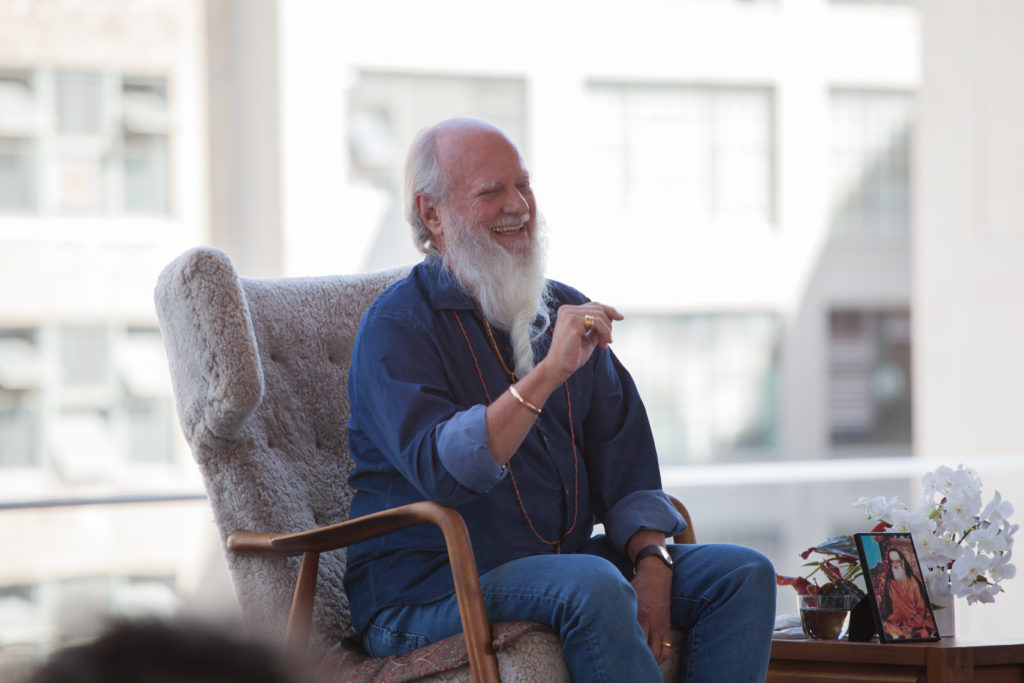Post-traumatic stress disorder (PTSD) is often associated with horrific war experiences during military deployment. Though the level of stress a soldier experiences may be extreme, many people experience traumatic triggers and reactions to a range of normal to abnormal events in life.
There are cases where meditation can help. Vedic Meditation has a unique ability to address the physiologically stored stress at the root of PTSD symptoms. It can assist those who have experienced trauma to heal and recover.
To best understand how Vedic Meditation affects PTSD, we need to define trauma and understand the condition. We’ll look at different forms of PTSD meditation and how Vedic Meditation specifically targets the stress at the root of the condition.
We’ll also discuss other kinds of help that may be required for those experiencing trauma-related symptoms, and how Vedic Meditation may make it easier to seek help at the appropriate time.
What is PTSD?
Post-traumatic stress disorder is a mental health condition that can develop after experiencing or witnessing a traumatic event. It is characterized by symptoms such as intrusive thoughts, nightmares, avoidance behaviors, hypervigilance, and heightened anxiety.
PTSD can interfere with daily functioning and lead to problems in personal relationships, work, and mental health. It is a complex condition that requires a comprehensive assessment and treatment approach.

What is Trauma?
Trauma refers to a deeply distressing or disturbing experience that overwhelms an individual’s ability to cope. Traumatic events can include:
- Natural disasters
- Accidents
- Physical or sexual assault
- War
- Terrorism
- Other life-threatening situations
The impact of trauma can vary from person to person, but can often lead to feelings of fear, anxiety, and emotional numbing. It can also cause physical symptoms such as increased heart rate, sweating, and difficulty sleeping. The long-term effects of trauma can include PTSD and other mental health conditions.
Common Connotations of Trauma
Though the accurate definition of trauma typically references life-threatening events, individuals can experience an inability to cope with non-life-threatening situations as well. A fight with a loved one, an uncomfortable illness, an embarrassing situation, or any number of undesirable events can create a stress response that the body is unable to handle.
Stressful events affect different people in different ways. While two soldiers may fight side-by-side in the same battle and see the same sequence of events, one may come home and experience long-term PTSD symptoms while the other is easily able to move on with life.
Similarly, someone who experiences a relatively minor emotional event – like a scary movie, a romantic disappointment, a professional mistake, or a minor injury – could experience the same level of PTSD symptoms as the soldier returning from a violent battle.
How can it be possible that minor events and major life-threatening experiences can create trauma?
When Thom discusses PTSD, he shares that he is convinced most of the Western world has PTSD at some level. Though the word ‘trauma’ has been overused and its meaning diluted, the consistent factor in most people’s experience with trauma in themselves and with others is that they are not very resilient to stress, and tend to react strongly in an internally repressed or externally expressed manner.
No matter how it manifests, the stress in a PTSD episode or any other kind of trauma response episode comes from a change in expectation that the brain and body are unable to cope with. As he shares in this podcast episode:
“So what is trauma? Trauma is how our body has an extreme reaction to changes in expectation. What is it that we expect?
“Some of us have very realistic expectations that are accurate. Other times we might have grossly inaccurate expectations about what is going to continue to be and what is not going to continue to be.
“And when we have inaccurate expectations and we do not possess very much adaptation energy then almost any change of expectation could qualify as ’trauma.’
“And so what’s the difference between someone who’s traumatized by a change of expectations, rapid change of expectations, overload of experience, and someone who’s not traumatized? The difference is the quality of adaptation energy.”
Change in Expectation
The onset of stress always comes from a change of expectation in our physiological or external environment. Our most basic instincts are designed to keep us in a ‘rest and digest’ state for most of the time, resetting each night while we sleep.
Occasionally, we’ll shift into ‘fight or flight’ to avoid danger. The body is designed this way for survival – but since most Westerners do not face life-threatening events, the brain has become less and less able to distinguish which signals are actually dangerous and which are not.
Our minds are constantly working on how we can be happier. Consciously or unconsciously, we form expectations of how our day will go. When things don’t go the way we expect (and sometimes even when they DO go the way we expect), our brains have to respond and adapt.
Most people have so much stress embedded in their physiology that the slightest change in expectation or shift in mood can set them off into an overwhelmed stress response.
Embedded Stress Memories in the Body
Even if the stress response doesn’t consciously register, it affects the brain and nervous system, and more memories are embedded into the physiology of triggers that may signal danger. We subconsciously try to avoid those triggers, many of which are completely benign: a child whining in the grocery store, a truck the same color as our ex’s truck.
With no way to remove the embedded stress memories in the body, we’ll continue to accumulate them until we’re constantly overwhelmed and consistently anxious.
This is the state that makes us vulnerable to ‘traumatic experiences.’ We have no adaptation energy to deal with changes in expectation in the first place, and then when a significant change occurs that we didn’t expect, we can’t handle it.
Adaptation Energy
In the Vedic Worldview, we refer to the capacity to respond to changes in expectation as adaptation energy. The more stress we’re able to release from the physiology, the more adaptation energy we’ll have. The more adaptation energy we have, the more easily we’ll respond to change with creativity, resourcefulness, and ease. The best type of meditation for trauma is one that can dramatically increase their adaptation energy, so that when triggers appear, they have the energy and adaptability to cope instead of reacting.

Reaction and Recovery
There are two factors to consider when it comes to gauging one’s ability to cope with stress and trauma.
One is the reaction: Do you react when a stressful event occurs? Do you blow up, meltdown, or internally analyze incessantly? Does your inner critic go off, or does your temper blow up? Do you seem okay on the outside, while feeling shocked, numb, or hopeless inside? These are all reactions that signal an inability to cope with a change in expectation.
The second factor is recovery time. How long does it take you to recover from a stressful event? Do you have to halt everything and switch to distracting or comforting activities? Do you have to talk through and analyze it? For the person who has enough adaptation energy, change is a non-event. They will forget it happened, or find it interesting. There is no reaction and no recovery time. Instead, they move on with their day.
Obviously, reaction and recovery are not an on-off switch. Along the journey of releasing stress and building adaptation energy, the improvement is incremental. You may notice that the same trigger bothers you less than it did before, or that you need less time to recover.
The only way to build the adaptation energy in a consistent, reliable way is to release the stress from the body every single day. This is possible with Vedic Meditation.
Vedic Meditation and Adaptation Energy
Vedic Meditation does not require you to concentrate or ‘not think.’ It allows unprecedented stress release from the body because it’s effortless. Thoughts are allowed. You simply repeat a meaningless sound, a Bija Mantra given to you by a qualified teacher during the Learn to Meditate course.
Your teacher will show you how to let the sound arise in your awareness and drift away effortlessly among your thoughts. As the mantra arises, it slowly calms the mind to a very low-excitement state. This is the state where the body can release stress.
When practiced for twenty minutes twice each day, Vedic Meditation can help you release stress and gain adaptation energy. That’s why many people who experience trauma responses turn to Vedic Meditation for PTSD sufferers.
People with PTSD practice the same technique as those who do not have mental health challenges, and in many cases, they experience more dramatic results as their physiology gains much-needed adaptation energy.
Different Forms of Meditation and PTSD
There have been studies on how different kinds of meditation affect PTSD, including this Minneapolis study that shows veterans who received Mindfulness-Based Stress Reduction reported significant reductions in PTSD symptoms, depression, anxiety, and physical symptoms compared to a control group.
Though many forms of meditation may assist the symptoms of PTSD and other mental health disorders, there are not many that allow the body to reach a hypo-metabolic state such that the body can permanently release embedded stress. Though it is important to participate in any kind of therapy or activities that soothe the symptoms, sufferers of PTSD will only cope with the condition rather than heal it if they don’t address the stress at the root cause.
Many people with mental health struggles find that once they start a Vedic Meditation practice, their thinking becomes clear enough to seek professional help and accelerate their healing journey. The best meditation for healing trauma is one that provides adaptation energy as a consistent daily habit.
Seeking Help
Vedic Meditation is not the end-all-be-all solution to PTSD or any mental health challenge, but it does provide the body with the adaptation energy to make good choices, react less to triggers, and seek help where needed.
There are practices that may not be the best meditation for complex PTSD. When someone with PTSD experiences a trigger and feels the overwhelm of stress come on, it doesn’t always help to close their eyes and concentrate. Sometimes the forms of meditation that require concentration only cause the mind to fixate more on the trigger rather than calming the trigger.
When a trigger comes on, it’s okay to feel the emotions and allow them to pass. We can acknowledge that our body is feeling overwhelmed and will eventually return to homeostasis. When we have a consistent Vedic Meditation routine and have enrolled the support of a community or professionals where needed, we can be confident that we’re on the path to healing.

The Best Meditation for PTSD
This is how Thom Knoles describes Vedic Meditation for PTSD:
“When we practice Vedic Meditation, not only are we less easily stressable, because we’ve been releasing stresses all the time, but our adaptation energy grows so if we do get stressed, the speed with which we can recover can be extraordinarily fast.
“So recovery from an overload of experience is also part of that. PTSD, post-traumatic stress disorder, is a disorder because the capability to recover from an overload has been somewhat mitigated.
“Vedic Meditation is the answer. And very often people say, only combat people get PTSD, or only people who witness some horrid act get PTSD.
“My own opinion as a professional in the field is that almost the entire population has some at least low-grade level of PTSD. This is why it’s an extremely urgent thing that we inspire more and more people on a daily, weekly, monthly basis to come and embrace all the beautiful effects of Vedic Meditation.”
Solving Problems with Vedic Meditation
If Vedic Meditation can provide adaptation energy and help PTSD sufferers, then it can help mitigate every other kind of stress response on the spectrum of trauma and reactivity. Thom talks about addressing any kind of problem head-on with Vedic Meditation, because of the resourcefulness and greater capacity each meditator gains as they continue to release embedded stress. As Thom says,
“Most real problems in an individual’s life have to do with the way that overwhelming and stressful phenomena in the past have accumulated as distorted memories in the cells of the body and which cause the person inappropriately to be constantly reacting as if those stressors are still happening in the present. Vedic Meditation tackles the problem of stress accumulation head-on.”
Pure Being
One of the unique features of Vedic Meditation is its ability to take our minds to their least-excited state, all the way to the place of no thought.
No thought does not mean ‘not thinking.’ It is rather a place where our awareness has merged with the field of Being, with consciousness itself. There are no thoughts in this state because our awareness is no longer individual. It is effortless and ultimately satisfying to the mind. This is the place where stress and triggers cannot reach the mind, and we experience our true nature beyond the stress.
We may not think about it or even realize it in our regular waking state, and yet our whole being has been influenced by pure Being. We take on subtle impressions that we are the same Being in that blissful thoughtless place, that we are totality.
As stress memories release from the body, and as the mantra takes us into the least-excited state to encounter pure being, we begin to replace the information coming from our stress memories with impressions from universal consciousness.
We may still experience the triggers and emotions from those triggers, and we’ll recover more quickly. We’ll see the triggers coming more easily, and deal with them with greater facility. We’ll slowly start to take on that we are not our stress or our triggers. We are totality, the same pure Being that awaits in each meditation.
It is a gradual and winding process, and when we are consistent with meditation and attuned to what our bodies need externally for support, we’ll inevitably improve.
Learn to Meditate
You can receive a mantra and learn to meditate through the in-person four-day course, The Learn to Meditate course. In it, a qualified instructor will spend an hour and a half with you each day for four days. You’ll receive your mantra, learn how to use it and why it works, and establish a twice-daily practice that will calm and inspire you.
To find an instructor or view Thom’s upcoming teaching tours, check out the Learn to Meditate Page here. You can learn valuable techniques for managing stress, anxiety, and the symptoms of PTSD.
Remember, healing from trauma is a journey, and Vedic Meditation can be a powerful tool that empowers you to move forward with greater peace and clarity. Take the first step today and begin exploring the transformative potential of guided meditation for PTSD.
You’re invited to learn from Thom from anywhere in the world, through the only Vedic Meditation podcast that discusses all areas of life through the lens of the Vedic Worldview.
